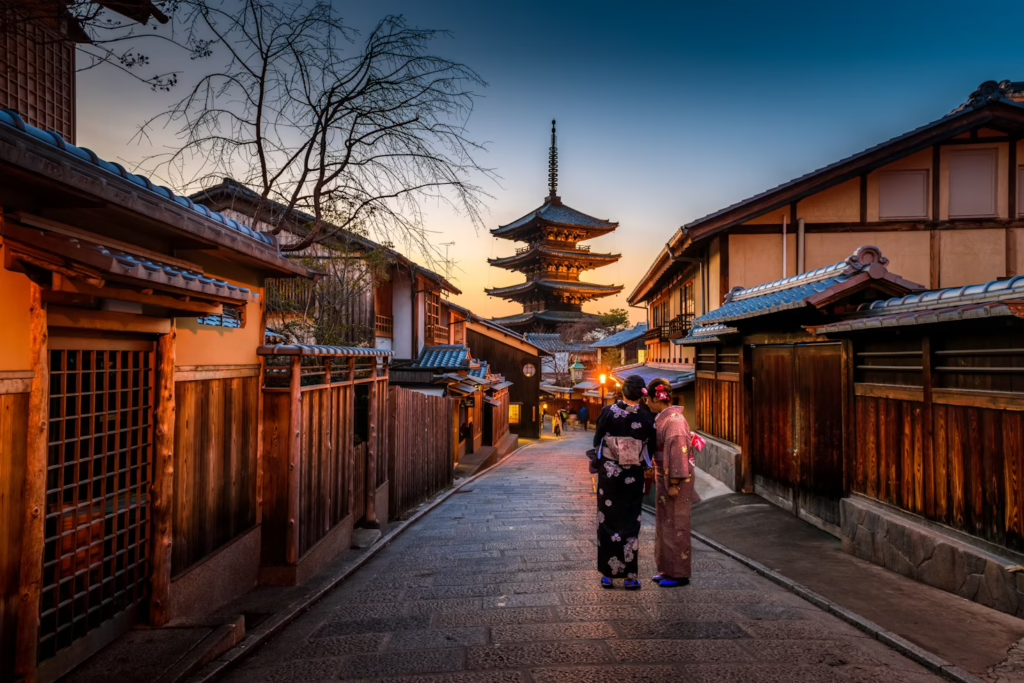Kyoto, the heart of Japan’s cultural heritage, offers a serene escape into a city where tradition meets tranquility. Known for its classical Buddhist temples, as well as gardens, imperial palaces, Shinto shrines, and traditional wooden houses, it’s a city that embodies the spirit of ancient Japan. Here’s why Kyoto should be a must-visit on your travel list, exploring its timeless beauty across different seasons.
Spring: A Symphony of Blossoms
Spring in Kyoto is synonymous with cherry blossoms. From late March to mid-April, the city transforms into a canvas of soft pink hues. The Philosopher’s Path, a stone walkway lined with hundreds of cherry trees, provides a particularly enchanting experience. The path follows a canal which, combined with the delicate cherry blossoms, creates a truly magical atmosphere perfect for leisurely strolls. Maruyama Park, with its iconic weeping cherry tree, becomes a hub of hanami (flower viewing) parties, where locals and tourists alike gather under the blossoms for picnics.
Summer: Festivals and Verdant Beauty
As the cherry blossoms fade, the verdant greens take over. Kyoto’s summers are lush, marked by the verdancy of its gardens and the celebrated Gion Matsuri, one of Japan’s most famous festivals. Held in July, this festival features stunning processions of floats, traditional clothing, and musical performances, encapsulating Kyoto’s rich cultural tapestry. The Kamo River, with its riverside dining platforms known as kawadoko, offers a unique dining experience where you can enjoy seasonal cuisine while cooling off above the flowing water.
Autumn: A Tapestry of Fall Colors
Autumn brings a fiery palette of reds, oranges, and yellows to Kyoto’s already picturesque landscapes. The best place to witness this colorful display is perhaps the Arashiyama Bamboo Grove, where the towering bamboo stalks are framed by fall colors, creating a stark and beautiful contrast. Temples like Kiyomizu-dera offer panoramic views of the city against a backdrop of autumnal colors, providing a perfect spot for photography and peaceful contemplation. The autumn leaves typically peak in late November, making it an ideal time for those seeking the quieter side of Kyoto.
Winter: Serenity and Snowscapes
Winter in Kyoto is serene, with the city often blanketed in light snow, giving its traditional architecture and gardens a quiet, ethereal beauty. Visiting the Silver Pavilion (Ginkaku-ji), with its garden covered in snow, offers a peaceful solitude not as easily found in busier seasons. The Japanese New Year is a fantastic time to visit, where you can experience local traditions like bell-ringing ceremonies at temples and the first shrine visit of the year, known as Hatsumode. Kyoto in winter also means enjoying seasonal delicacies like yudofu (hot tofu) and bubbling nabe (Japanese hotpot), which are perfect for the chilly temperatures.
Cultural Immersion: Experiencing Kyoto’s Living Traditions
Kyoto is not just about scenic beauty; it’s also about immersive cultural experiences. Participate in a tea ceremony where you can learn about the intricacies of this age-old tradition. Visit a traditional machiya (wooden townhouse) to see the architecture and design that have been preserved for centuries. For those interested in Japanese textiles, Nishijin Textile Center offers demonstrations and workshops on how to weave traditional kimonos.
Zen and the Art of Garden Design
The zen gardens of Kyoto, like those at Ryoan-ji, are minimalist yet profound, designed to evoke meditation and contemplation. The rock gardens here, composed of carefully placed stones and raked gravel, encourage visitors to find inner peace and reflection. Exploring these gardens is a lesson in Zen principles and aesthetics, embodying the philosophical and spiritual depth of Japanese culture.
Accommodations: From Ryokans to Modern Stays
Staying in a ryokan, a traditional Japanese inn, is a must when in Kyoto. These establishments offer a taste of Japanese lifestyle, from tatami floors and futon beds to onsen (hot spring) baths. For a more contemporary stay, Kyoto also offers modern hotels that blend traditional design with modern comforts, located conveniently near transportation hubs and major sightseeing spots.
Getting Around
Navigating Kyoto is a breeze thanks to its comprehensive public transport system. The city’s buses and subways cover most tourist destinations. However, renting a bike is a wonderful way to see the city at a slower pace, allowing for unplanned explorations down narrow alleyways and hidden neighborhoods.
Culinary Delights
Kyoto is also a city for the culinary curious. Known for its kaiseki cuisine, a traditional multi-course Japanese meal, the city offers a chance to experience the art of Japanese fine dining. Vegetarians can rejoice in shojin ryori, Buddhist temple food that is entirely plant-based. Don’t miss out on trying Kyoto’s matcha, a finely ground green tea, which can be enjoyed in various forms from tea to desserts.
Kyoto, with its blend of history, culture, and natural beauty, offers a travel experience that transcends the ordinary. Each season paints the city in a new light, inviting visitors to return time and again for a different experience. Whether you are walking through a vibrant festival, meditating in a Zen garden, or enjoying a quiet moment under the cherry blossoms, Kyoto promises a journey filled with tranquil traditions and seasonal splendors. It’s a city where the past lives in the present, making every visit a step back in time into the heart of Japan’s cultural heritage.
